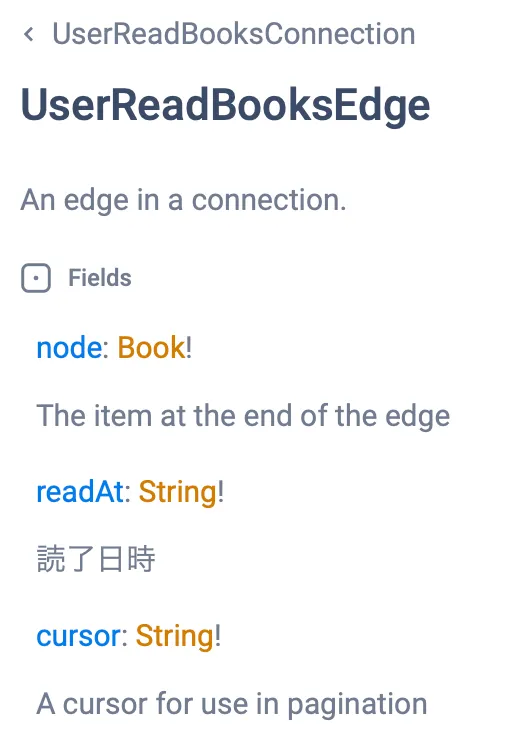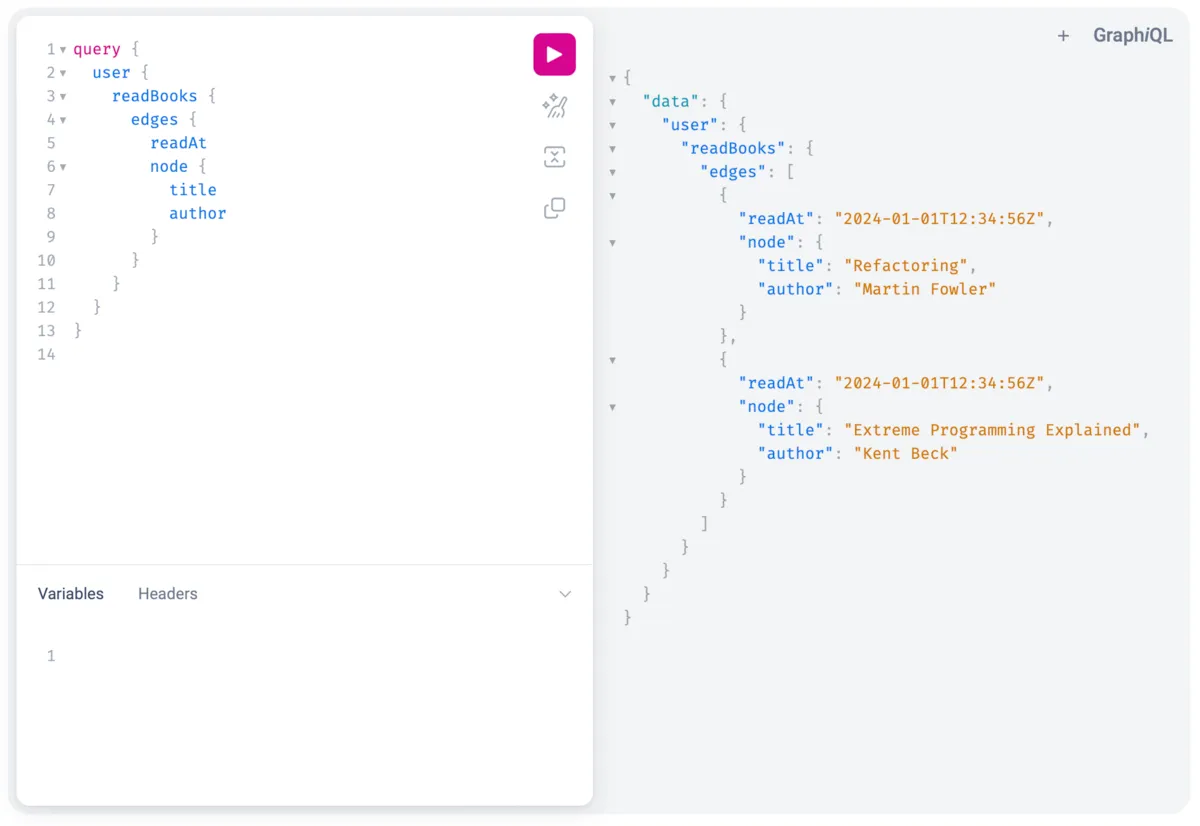async-graphqlで独自の名前とフィールドを持つconnection/edgeを定義する
GraphQLで、適切にグラフ上のノード間の関係を示すために、connectionやedgeに独自の名前をつけて、独自のフィールドも追加したいことがある。
Explaining GraphQL Connections | Apollo GraphQL Blog
Instead think of them as the relationship between two nodes, and add fields that are appropriate for that relationship
async-graphqlでこれを実現するには、Connectionの型パラメータに独自の名前とフィールドを表す型を渡せばよい。
実装したいスキーマ
今回は次のスキーマを実装する。ユーザーと書籍がリソースとして存在して、ユーザーが書籍を「読了」したという関係性をUserReadBooksConnectionで表現する。UserReadBooksEdgeはreadAt(読了日時)を持つ。
type Book { id: Int! title: String! author: String!}
type Query { books: [Book!]! user: User!}
type User { """ ユーザーが読了した書籍 """ readBooks: UserReadBooksConnection!}
type UserReadBooksConnection { pageInfo: PageInfo! edges: [UserReadBooksEdge!]! nodes: [Book!]!}
type UserReadBooksEdge { node: Book! cursor: String!
""" 読了日時 """ readAt: String!}async-graphqlのConnection
async-graphqlのConnectionの定義は次のようになっている[^1]。
pub struct Connection< Cursor, Node, ConnectionFields = EmptyFields, EdgeFields = EmptyFields, Name = DefaultConnectionName, EdgeName = DefaultEdgeName, NodesField = EnableNodesField>where Cursor: CursorType + Send + Sync, Node: OutputType, ConnectionFields: ObjectType, EdgeFields: ObjectType, Name: ConnectionNameType, EdgeName: EdgeNameType, NodesField: NodesFieldSwitcherSealed,{ // ...}型パラメータのうち、今回着目するものの意味は次のとおり。
ConnectionFields , EdgeFields
connectionとedgeの独自フィールドの型。普通のフィールドと同じく、メソッドとしてリゾルバを持つObjectなどを渡せばよい。指定しないときはconnection::EmptyFieldsを渡す。
Name, EdgeName
ConnectionNameTypeとEdgeNameTypeを実装した構造体を渡せばよい。指定しないときはconnection::DefaultConnectionNameを渡す。
独自のconnectionを定義
async-graphqlのConnectionに適切な型パラメータを渡して、独自の名前やフィールドを持つconnectionを定義する。
use async_graphql::{ connection::{Connection, Edge, EmptyFields}, types::connection::{ConnectionNameType, EdgeNameType}, Object, OutputType, Result, SimpleObject,};
// ...
// 独自のconnectionを定義する// 型の記述が長くなるので別名をつけるtype UserReadBooksConnection = Connection< i32, Book, EmptyFields, UserReadBooksEdgeFields, UserReadBooksConnectionName, UserReadBooksEdgeName,>;
// 普通のフィールドと同じく、メソッドとしてリゾルバを持つObjectを実装struct UserReadBooksEdgeFields;
#[Object]impl UserReadBooksEdgeFields { /// 読了日時 async fn read_at(&self) -> &'static str { "2024-01-01T12:34:56Z" }}
// ConnectionNameTypeを実装した構造体で独自のconnection名を定義struct UserReadBooksConnectionName;
impl ConnectionNameType for UserReadBooksConnectionName { fn type_name<T: OutputType>() -> String { "UserReadBooksConnection".to_string() }}
// EdgeNameTypeを実装した構造体で独自のedge名を定義struct UserReadBooksEdgeName;
impl EdgeNameType for UserReadBooksEdgeName { fn type_name<T: OutputType>() -> String { "UserReadBooksEdge".to_string() }}このconnectionを使って、フィールドUser.readBooksを次のように定義できる。
use async_graphql::{ connection::{Connection, Edge, EmptyFields}, types::connection::{ConnectionNameType, EdgeNameType}, Object, OutputType, Result, SimpleObject,};
// ...
/// 書籍#[derive(SimpleObject)]pub struct Book { id: i32,
/// 書名 title: String,
/// 著者 author: String,}
// 書籍のダミーデータを作るファクトリ関数fn get_books() -> Vec<Book> { let book1 = Book { id: 1, title: "Refactoring".to_string(), author: "Martin Fowler".to_string(), };
let book2 = Book { id: 2, title: "Extreme Programming Explained".to_string(), author: "Kent Beck".to_string(), };
vec![book1, book2]}
struct User;
#[Object]impl User { /// ユーザーが読了した書籍 async fn read_books(&self) -> Result<UserReadBooksConnection> { let mut connection = UserReadBooksConnection::new(false, false); connection.edges.extend( get_books() .into_iter() .map(|book| Edge::with_additional_fields(book.id, book, UserReadBooksEdgeFields)), );
Ok(connection) }}read_booksの中で、Edge::with_additional_fieldsを使ってUserReadBooksConnectionのインスタンスのedgesに独自フィールドを持つedgeを追加している。
結果
スキーマは独自に定義した名前のconnectionとedgeを提供しており、UserReadBooksEdge.readAtが追加されている。

GraphiQLでクエリすると次のようになる。edgeに追加された独自フィールドを取得できている。
